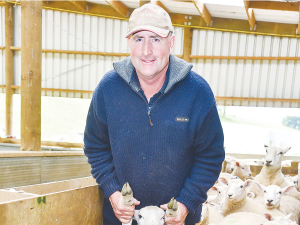Breeder credits late uncle for hair sheep success
Southland breeder Tim Gow attributes the success of his Shire breed of hair sheep to the expert guidance of his uncle, the late Dr Scott Dolling, who was a prominent Australian animal geneticist.
 Waimate farmer Tim Mehrtens says he has been pleasantly surprised at the Wiltshire's mothering ability and pre-weaning growth rates.
Waimate farmer Tim Mehrtens says he has been pleasantly surprised at the Wiltshire's mothering ability and pre-weaning growth rates.
Continuing poor returns for crossbred wool coupled with the emergence of triple drench resistance is driving an increasing number of sheep farmers to consider making the shift to low-input, no-shear Wiltshires.
Aside from shearing, the costs of crutching, dagging and flystrike are all eliminated with these shedding sheep. Meanwhile, Wiltshires are said to be more resistant and resilient to internal parasites than their wooly counterparts.
Will Pears, stud manager at North Canterbury's Mt Cass Wiltshire stud, says last year's inaugural sale exceeded all expectations in terms of price and interest. He is expecting the same at this year's sale on January 19.
Pears says last year more than 100 buyers from around the country competed strongly for both rams and ewes and feedback from purchasers has been overwhelmingly positive.
One of those buyers was Waimate farmer Tim Mehrtens. He admits it took a leap of faith in buying Wiltshire ewe lambs and rams at the Mt Cass's sale but was rewarded with a good lambing percentage and very good pre-weaning growth rates.
Mehrtens, who farms 215ha of rolling hill country, says the shift to Wiltshire genetics was driven by frustration with poor returns for wool. While he has been buying very good composite ewe lambs, in 2020 the difference between shearing costs and the wool cheque left him $3,500 out of pocket.
The first crop of pure Wiltshire and Wiltshire cross lambs, born last spring, exceeded expectations. Mehrtens says he was pleasantly surprised at the pre-weaning growth rates and their mothering ability.
Forced to wean early due to limited processing space, he says 220 twin male lambs killed out at 17.5 kgCW and a line of Wiltshire cross lambs averaged 17.7 kgCW.
Mehrtens has also noticed that a lot of the first cross lambs have started to shed.
"I'm stoked with the results," he says.
Effective from 1 January 2026, there will be three new grower directors on the board of the Foundation for Arable Research (FAR).
The National Wild Goat Hunting Competition has removed 33,418 wild goats over the past three years.
New Zealand needs a new healthcare model to address rising rates of obesity in rural communities, with the current system leaving many patients unable to access effective treatment or long-term support, warn GPs.
Southland farmers are being urged to put safety first, following a spike in tip offs about risky handling of wind-damaged trees
Third-generation Ashburton dairy farmers TJ and Mark Stewart are no strangers to adapting and evolving.
When American retail giant Cosco came to audit Open Country Dairy’s new butter plant at the Waharoa site and give the green light to supply their American stores, they allowed themselves a week for the exercise.

OPINION: Your old mate welcomes the proposed changes to local government but notes it drew responses that ranged from the reasonable…
OPINION: A press release from the oxygen thieves running the hot air symposium on climate change, known as COP30, grabbed your…